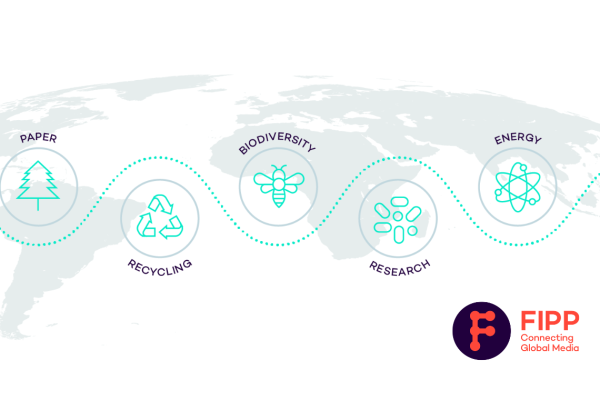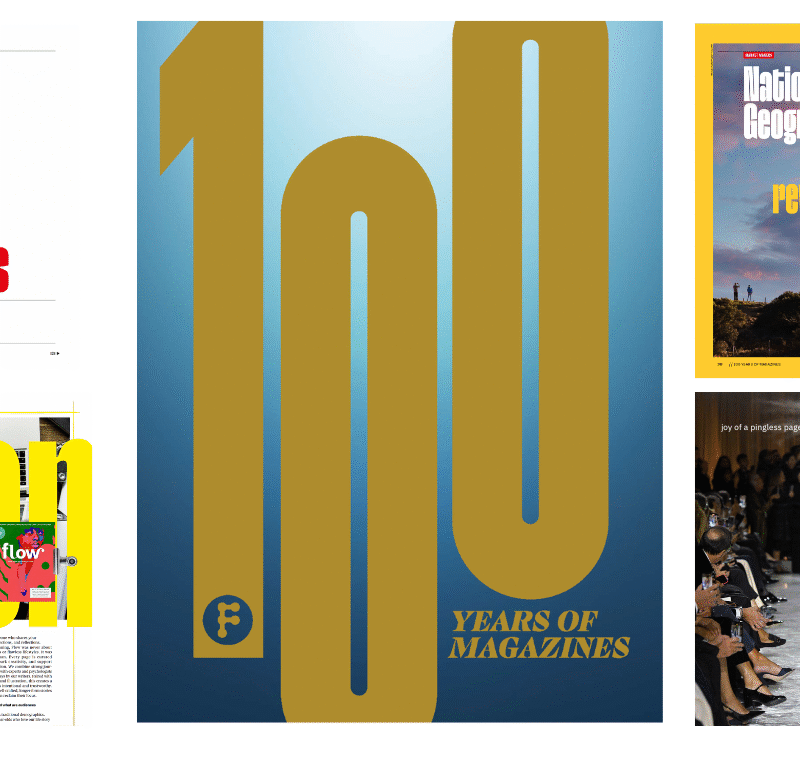FIPP Global Media Sustainability Tracker – April 2024
Welcome to the latest edition of the FIPP Global Media Sustainability Tracker! From reducing carbon emissions and improving employee well-being, to protecting press freedom and accurately reporting on climate change, today’s media has a key role to play in the prosperity of tomorrow’s people, places, and planet(s).
FIPP invites media owners around the world to share their latest updates with us. As a network, we are greater than the sum of our individual parts and can be an impactful force in helping to influence change on a global level. Got a story to share? Simply get in contact with us today.
This month we learn why embracing sustainability has become a strategic imperative for publishers, whether paper content will ever be as sustainable as digital and the ongoing global campaigns to reduce the carbon footprint of digital advertising.
Here are the latest updates.
International news
April 2nd: Digiday has an important article about why embracing sustainability became a strategic imperative for publishers
Eric Shih, Chief Operating Officer, Cedara, notes that “last year, the Global Alliance for Responsible Media (GARM), introduced an action guide for advertisers to decarbonise media emissions. The top recommendation was for brands to ensure that their media suppliers are transparent with emissions and “sustainability-assured.”
GARM has also merged its working groups with Ad Net Zero to develop cross-channel media emissions measurement standards, which will be introduced by June 2024. A global industry measurement framework for carbon will undoubtedly accelerate a push for emissions transparency across the media supply chain and publishers.”
Eric concludes that publishers face a perfect storm of pressure from consumers, legislators and industry bodies and need to act decisively to reap the many benefits that adopting sustainable practices delivers.
Feb 21st: Retail consumers are more concerned about coolness than they are about sustainability. And this is due to the power of celebrities and influencers.
That’s the findings of a recent survey by YPulse reported by Just Style.
It concludes “that 69% of 13 to 39-year-olds are more likely to purchase brands that are considered cool than those that are not. While consumers buying products deemed cool is nothing new in the world of retail and apparel, the growing sway of celebrities and influencers on brands’ success in the age of social media makes it especially pertinent today.”
However the report also notes; “Interestingly, while shopping sustainably is a growing factor younger consumers are taking into consideration, results from a GlobalData survey suggest that it is perhaps not as disruptive as once thought.”
“GlobalData has found that of those who have ordered items from abroad in the past year, 51.1% of consumers did not consider the environmental impact of their order, and the remaining 48.9% who did consider the environmental impact, were not deterred from making an order,” says analyst Sophie Mitchell.
Feb 20th: AdAge reports that The World Federation of Advertiser’s Global Alliance for Responsible Media (GARM) is collaborating with Ad Net Zero to create a usable framework for media sustainability.Due in the summer is a programme that will serve as a common, voluntary solution for measuring emissions across the advertising industry.
Jan 24th: In a wide-ranging article that has significant relevance to publishers The Guardian looks at whether digital really is greener than paper, noting that the paper industry is now challenging the notion that digital is always more sustainable.
“What people often don’t realise is that the paper-making process is sustainable, and claims to the contrary are misleading to the consumer,” said Mark Pitts, executive director of printing-writing, at the American Forest And Paper Association (AFANDPA).
According to the organisation, more than 65% of paper in the US was recycled in 2012, making paper the nation’s most recyclable commodity. Over the past century, forest coverage in the northern part of the country, from Minnesota to Maine, has actually increased by 28% according to the United States Department of Agriculture’s Forest Service.
Jan 11th: Digiday has a very comprehensive guide to sustainability in the advertising industry. It says that a lack of standards for measuring carbon emissions has prevented sustainability from becoming a deciding factor for how ad budgets are executed. But adds that “Sustainability standards are on their way, however. The Global Alliance for Responsible Media (GARM) and Ad Net Zero created a number of working groups in October that are tasked with building the Global Media Sustainability Framework. The full set of guidelines are due to be published in time for the Cannes Lions Festival this June, though solutions will be distributed on a rolling basis between now and then as they are completed, according to Rob Rakowitz, initiative lead for GARM.”

UK
April 10th: A year ago international publisher Haymarket announced the launch of a revamped sustainability strategy – Impact – which it says aligns closely with four of the United Nations Sustainable Development Goals (UN SDGs), including SDG 13: Climate Action.
A year on and InPublishing reports that the company has revealed how it is faring on reaching its goals. It has been working with Normative, who partners with climate change organisations including the UN Race to Zero, SME Climate Hub, and others.
After supplying all global and local data to Normative, Haymarket has received the first report of its emissions for the 2022/23 financial year.
Haymarket’s global Scope 1 emissions accounted for 0.05% of the total and refer to direct emissions from sources that are owned or controlled by the organisation.
Haymarket’s global Scope 2 emissions represent 3% of the total and refer to indirect emissions from the generation of purchased energy. Its scope 3 emissions account for 97% – of the total global emissions and include emissions from purchased goods and services, transportation and distribution, business travel, and employee commuting. Purchased goods and services represent the largest emissions at 68% of the company’s global total.
The company says that the figures will enable it to work out how to achieve its stated net zero emissions target.
March 13th: In a provocative article for Media Leader Hannah Mirza, founder and CEO of Responsible Marketing Agency, has challenged brands to make sustainability issues business critical.
She highlights advertising and its huge carbon footprint saying that a million ad impressions is equal to a metric ton of CO2e — the same as one passenger’s round-trip flight from Boston to London, 121,000 fully charged smartphones or 2.4m plastic straws (source: Sharethrough) – and challenges brands, agencies and media companies to do something to address this.
In particular, Hannah says brands can’t leave it to publishers who have issues of their own. She argues
“An easy move for brands and agencies is simply to demand publishers present them with green media alternatives. This is understandable, but perhaps not all that fair. Publishers, already struggling to keep the lights on under heavy pressure from Google, Meta and others, can’t be expected to clean up the digital supply chain single-handed.”
Finally, she says how “Programmatic’s multiple auctions and huge inefficiencies put it very reasonably in the firing line, as its greatest asset is also its weakness — it is awash with data and its impact is laid bare for all to see, unlike that of walled-garden sectors such as social and search.”
She concludes “Programmatic has work to do, but it doesn’t deserve to carry the can for the entire digital advertising sector.”
March 1st: Media Leader has a profile of a new book, Sustainable Advertising, which looks at how brands and agencies can help create a better future for all.
The authors are Matt Bourn, director of communications at the Advertising Association and Seb Munden, chair of Ad Net Zero.
Sustainable Advertising argues among other things that there can be economic benefits to adopting net zero for publishers, agencies and brands.
They argue “If you follow the logic that every pound of advertising in a net zero economy by 2050 will be spent by a business promoting a sustainable product or service, we can say now that the most successful media owners will be those that grow their ad inventory in line with that logic way ahead of 2050.”
Jan 16th: Mail Metro Media has unveiled its “Shades of Green” research, which urges brands to help readers make eco-conscious decisions through clearer communications.
Newswork reports that the research found only 3% of Brits believe climate change does not exist. However, while the UK public are concerned about the environment, this concern does not manifest itself equally.
The findings show people exist on a ‘shades of green’ continuum, comprised of ‘dark greens’ (7% of climate-conscious Brits — those who often factor the environment into their purchase decisions), ‘nuanced greens’ (40% — those who sometimes factor it in) and light greens (54% — those who occasionally do). While the proportion of dark greens does not vary per generation, younger generations are more likely to consider themselves ‘nuanced’.
Nov 28th: Bauer Media has begun to use the Love Paper logo to highlight the sustainability of its printed magazines. According to its press release “The initiative signifies Bauer’s proactive stance in promoting the sustainable aspects of their print production and its commitment to behaving in an environmentally responsible way.
The Love Paper campaign aims to improve perceptions and raise awareness of the sustainability and attractiveness of print, paper, and paper-based packaging.
The campaign echoes Bauer’s long-standing commitment to environmental stewardship as outlined in its most recent Sustainability Report, which stated a commitment to source paper from sustainable partners. As such, it works diligently to ensure that the paper used in its magazines is responsibly sourced from sustainably managed forests. By collaborating with suppliers who adhere to strict sustainability standards, Bauer actively contributes to the preservation of biodiversity and the overall health of the planet.
“We are proud to support the Love Paper campaign and showcase the sustainable story of our printed magazines,” said Gareth Jones, Paper Manager, Bauer Media. “Our commitment to sustainability is ingrained in our corporate values. By using the Love Paper logo, we hope to educate our customers about the environmental attributes of our magazines and inspire others in the industry to do the same.”
EUROPEAN UNION
April 10th: Anglo-German publishing group Springer Nature has issued an update on its sustainability initiatives, It concludes that twenty-four percent of colleagues (approximately 2,250 people) are part of Springer Nature’s sustainability effort, “participating in employee networks dedicated to topics such as diversity, advocacy. and improving the carbon emissions of our offices. Colleagues also volunteer across 17 [United Nation Sustainable Development Goal] working groups on projects to advance the goals.”
March 28th: French company Prisma Media has announced it is joining with 17 other agencies in SRI’s new Sustainable Digital Ad Trust programme, The initiative seeks to promote more responsible advertising whether technological, business or environmental.
The programme has three key themes; Mastery of the distribution environment, Optimization of the technological value chain and a CSR approach.
March 21st: ExchangeWire has a round-up of how far the European advertising ecosystem has gone in an attempt to pave the way for a more sustainable future.
In response to evolving attitudes and regulations, the industry is adapting. Recent ExchangeWire and OpenX research found that three quarters of European marketers deem sustainability metrics to be a top priority for their businesses, up from 43% last year. Meanwhile, our research into the APAC region found industry respondents plan to allocate 47% of their budget over the next year to carbon-neutral partners.
Richard Ottoy, GM EMEA at Sharethrough – a supply-side platform creating a sustainable advertising ecosystem – describes how the industry has started to take sustainability more seriously. He notes, “We’ve seen a measurable increase in some key indicators including the inclusion of sustainability questions in most agency RFI’s which they use to evaluate preferred partnerships.”
Jan 23rd: In a blog post legal company Osborne Clarke has outlined how the EU has adopted regulation that tightens the rules around sustainability in advertising.
The article reports “On 17 January 2024, the EU Parliament adopted the “Directive of the European Parliament and of the Council amending Directives 2005/29/EC and 2011/83/EU as regards empowering consumers for the green transition through better protection against unfair practices and better information” (the text of the directive can be found here).
It has full details of the change along with some analysis.
USA
April 19th: Hearst Media is continuing to underline its position as a leading voice on sustainability issues by hosting a pair of conferences in the USin late April 2024. On April 23rd it focuses on the future of city life in an event on sustainable cities. The Hearst Sustainable Cities Summit 2024 is an invite-only, in-person event convening industry leaders to explore the innovative designs, policies and technologies that are reshaping the world’s urban landscapes. Three panel discussions will feature architects, policymakers, city planners and environmental advocates in provocative conversations about the ideas and solutions shaping the future of sustainable cities.
On April 26th Hearst is hosting the Hearst Eco-Conscious Living one-day virtual summit which will major on a variety of topics such as the circular economy, regenerative farming, electrification, deforestation and sustainable design. The event which is freely available via a livestream features the Hearst editorial team in discussion with sustainability experts such as Janelle Maiocco, Founder and CEO, Barn2Door, Fernando Pagés Ruiz, Home Builder and Author, “Building an Affordable House” and Sheila M. MorovatiFounder and President, Habits of Waste.
Feb 11th: Solitaire Townsend, an entrepreneur and author, has written an article in Forbes about how he believes that sustainability marketing has got trickier for brands including publishers. He points to a range of legislation from across the globe that has been created to counter greenwashing.
Solitaire’s advice to marketers and business owners is to “learn the regulations inside out. Look at the latest rules in your own country, and keep an eye on regulations emerging worldwide – it’s worth seeing the whole picture, to know where things are headed. Invest time, and hire experts, so that you and your team can stay up to date on these fast-changing rules. And test your agency’s knowledge of the latest regs.
But, the best prevention of greenwash isn’t just knowing rules: it’s about shifting your approach to making claims in the first place.”
Jan 22nd: Could publishers learn something from influencers about communicating the importance of sustainability issues? That’s the concept explored by Dylan Siegler SVP, Sustainability GreenBiz Group in an article for GreenBiz.
Citing several examples of influencers who major on sustainability Dylan says “There is emerging hope that social media creators can play a part bringing about the mass behaviour change necessary to decarbonise our economy — or, at the very least, raise awareness of what to do and how (such as shop for products that are sustainable). When creators land sponsorship deals, it becomes an entrepreneurial endeavour too.”
Dylan finishes the article by offering some advice to publishers and brands about communicating their sustainability messages including keeping to the point and being totally transparent.
Jan 12th: Business News Daily takes the microscope to a topic that has generated a huge amount of debate in recent years – greenwashing. The writer, Carylann Edwards offers two key bits of advice to brands and media companies as to how to avoid being caught out over sustainability issues.
- Make your claims clear and easy to understand. Include details such as specific units of measurement (e.g., “70% organic cotton” rather than “made with organic cotton”) and specific certifications and verifiable endorsements from credible third-party eco-organizations, such as the Sierra Club or Greenpeace.
- Back up your sustainability claims with data. Keep current data available, and update it on your website and anywhere else you make sustainability claims. Only use data that can be verified. If possible, include credible third-party certification from sources such as the Carbon Trust Standard, Forest Stewardship Council, Rainforest Alliance, or Energy Star.
Oct 30th: Jennifer Gaier of Forbes has unveiled her top five marketing trends for 2024 and in at number three is sustainability and ethical marketing. She says “The modern consumer is not just interested in purchasing a product or service; they’re keen on understanding the brand’s values, particularly concerning environmental and social responsibility. This trend, spurred by global challenges like climate change and social injustices, has led to a surge in brands promoting their sustainability initiatives and ethical practices. From eco-friendly packaging to fair trade sourcing, marketing in 2024 is as much about values as it is about value.”
Canada
March 14th: Canadian media companies will need to keep an eye on new proposals from the Canadian Sustainability Standards Board (CSSB). ESG Today reports the release of the new standards for reporting sustainability and climate change requirements may form a significant step towards the introduction of mandatory climate-related reporting requirements for Canadian companies.
AUSTRALIA / ASIA
Jan 30th: Marketing Initiative takes a long look at the recent EU legislation and its bid to curb greenwashing. It wonders what the implications of the move will be for Asia and whether the continent will adopt similar frameworks.
The article pinpoints the key issues in Asia noting; “Sustainability reporting is now mandatory in territories such as China, India, Japan, South Korea, Hong Kong and Singapore. However, a report by professional services firm EY in December 2022 found that while more companies now disclose environmental, social and governance (ESG) data, following through with action remains an issue.
“Without question, countries such as Singapore’s business-friendly environment, lack of clear regulations around environmental claims, weak environmental NGOs and timid mainstream media have meant that brands are free to make whatever green claims they want,” said Robin Hicks, deputy editor of Eco-Business said.
“Low consumer awareness of what greenwashing is and why it is a problem has meant brands can get away with greenwashing, which is often unintentional. Culturally, there is less push back against greenwashing in Asia as there are in other countries. There is a general sense that businesses and the government can be trusted to make genuine green claims,” he added.
Dec 5th: The World Editor’s Forum has highlighted a new report that paints a grim picture of media reporting on climate change in southeast Asia.
The inaugural “Global Climate Journalism Insights: Southeast Asia” report, authored by global journalism initiative climateXchange (cXc), tells of a journalism landscape fraught with resource challenges, fear of reprisal and audience apathy.
cXc Impact Manager Dr Carmen Nicoara who compiled the report concluded:
“The standout insight from this report is the stark contrast we see in Southeast Asia—a region rich in environmental narratives, yet grappling with public disengagement. Our task is to break this cycle of disconnection: we need a shift in storytelling. It’s become clear that for climate awareness to flourish, newsrooms in this region must come together, sharing strategies and stories“.
October 9th: Despite the deprecation of third-party identifiers and global economic turbulence, sustainability is a key focus for professionals within the Japan and Asia-Pacific (JAPAC) region, according to a new research report, Sustainability in Advertising – JAPAC 2023 by ExchangeWire, in association with OpenX.
The majority of those surveyed deemed sustainability metrics to be important to their business, while simultaneously converting theoretical applications into tangible business outcomes, with nearly half (47%) of all marketing budgets across the JAPAC region set to be allocated to carbon-neutral partners within the next year, as per the report. JAPAC refers to the geographical region that includes Japan and various countries in the Asia-Pacific region.
AFRICA
4th Dec: CNBC Africa has an update from COP28 which focuses on the role the media needs to play in reporting climate change issues.
It says… “Media has an outsized role to play in tackling climate change. Consequently, industry leaders are tasked with the all-important role of providing both accurate and engaging information to ensure media platforms are constructively enhancing the policy dialogue and countering the phenomenon of misinformation.”












